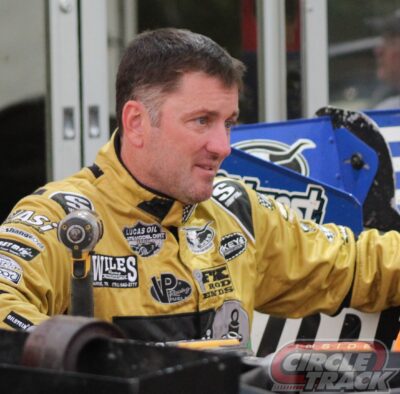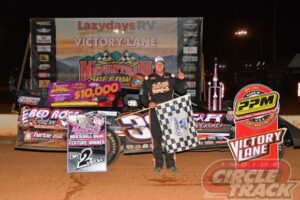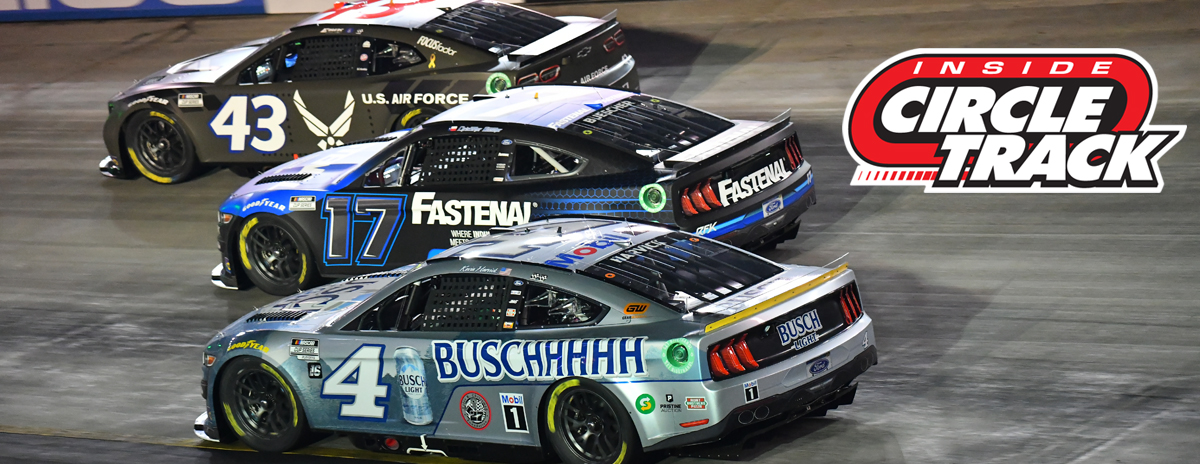This week’s edition of the Turn 2 Blog that would have normally been posted on InsideDirtRacing.com has been moved to this sire due to a technical issue which we are working to correct. Sorry for the inconvenience.
The older veterans of Dirt Late Model racing are definitely letting it be known that they have no plans to just fade away into the darkness, aren’t they?
Richard: After his win in the Lucas Oil Late Model Dirt Series feature this past Saturday night at Talladega Short Track, 48-year-old Tim McCreadie commented that “A lot of times when you get to this point in your career they’re talking about young guys and they’re talking about selling T-shirts. That’s good. Hopefully they keep me hanging around and we just keep cashing checks.” That definitely doesn’t sound like a man who has plans to just fade into the darkness.
On Thursday night of last week, 56-year-old Dale McDowell showed that he could still get the elbows up on a tight bullring as he drove from his 10th starting spot to a $22,022 win in a Castrol FloRacing Night in America-sanctioned event at the Tri-County Race Track. On this past Tuesday evening, 50-year-old Jimmy Owens completely dominated one of that same series events at 411 Motor Speedway.

Tim McCreadie
This form of motorsports, more than most others, seems to reward age and experience every bit as much as it does youth and bravado.
We have seen multiple wins this year by the likes of Chris Madden, Dennis Erb Jr., Jimmy Owens, Dale McDowell, Shane Clanton and others well past the age of 40. Almost all of whom talk about not knowing how much longer they can do this while at the same time not slowing down.
Yes, there is a very strong crop of drivers under the age of 30 such as Brandon Sheppard, Bobby Pierce, Hudson O’Neal and Devin Moran who have already accomplished great things and will no doubt do much more before they are through. But as an old guy of 55 myself, I’m kind of glad to see that the grizzled veterans can still get it done.
Michael: There are some really talented young racers in the sport. A good many of them don’t know how to really race, they just go fast. O’Neal, Moran, etc. know how to race and they win. That’s the difference between them and other young racers.
The older drivers are still flourishing because as passing becomes harder in many of these races, they rely on their experience to get to the front and win. They’re not throttle mashers like many of the younger drivers are. They go really fast when they need to.
I think it’s great for the sport when drivers in their 50’s can win as many races as the drivers in their 20’s. There aren’t a lot of them in most other forms of racing.
What are your thoughts on how Tim McCreadie is finishing out the 2022 season?
Richard: To continue the thoughts from the previous question, McCreadie just seems to be getting stronger as the season goes on. At one point, it looked like Brandon Sheppard might run away with the Lucas Oil Late Model Dirt Series title but the Donald Bradsher-owned Paylor Motorsports team with backing from Longhorn Chassis and Bilstein Shocks just kept charging and have now claimed their second consecutive series championship.
McCreadie has won three of his last five starts collecting payouts of $40,000, $20,000 and $15,000.
While I’m sure after a long season with more racing to do than ever before everyone is exhausted but this might be one of those situations in which this driver and crew don’t want to see it end. Of course, the challenge now, with another title secured, is to see if they can carry this show of strength into next year.
Michael: I think a lot of this has to do with not racing as much as the other drivers in the series. While some drivers have already raced 70-80 times, McCreadie and his team have been a little more selective. I think they hit a speed bump after his hard crash at Bristol. It seems like once they got past that and got caught up with their inventory, the team has hit its stride. It’s like the old saying, sometimes less is more.
Big payouts aren’t just limited to Super Late Model racing anymore, are they?
Richard: Tyler Bare recently collected $50,000 for his victory in the Fastrak World Championship at the Virginia Motor Speedway. That event was billed as the richest Crate Late Model feature of the 2022 season. This past weekend, Michael Brown earned $10,000 in an American All-Star Series-sanctioned Crate Late Model race at Smoky Mountain Speedway. Crate Racin’ USA has events coming soon set to pay $10,000 and $27,000-to-win respectively at Golden Isles Speedway and All Tech Raceway respectively.
It seems to me that purse amounts that just a few years ago were considered nice payouts for a Super Late Model show have now become very ordinary for that form of racing but are becoming more of the norm for bigger CLM events. It wasn’t that long ago that tracks would proudly boast of $10,000-to-win national touring series races for Supers but those are becoming much more rare these days. At the same time, tracks now boast of $10,000-to-win for Crates.
No track owner or promoter has ever opened their financial books for me to look at(as if I would even understand it) but my guess is that the hope is to make most of the money from a big Crate race at the back gate. Where a $10,000 purse might not attract a throng of Supers, it could land 40-50 CLM teams. With entry fees and pit passes, that number of cars would go a long way toward paying the purse where fewer SLM cars and their typically smaller numbers of crew members might not match the overall payout.
From the competitor’s side, I am glad to see the guys who might not be as well known nationally get to race for bigger paydays. At the same time, if the amount of winnings continue to rise, the expense to win those amounts will also rise as teams buy more expensive parts to gain an advantage. Also, those amounts of money will begin to attract big name drivers and with fewer of them running full-time on the national tours, they will find room on their schedules to compete for $25,000 or $50,000.
But the changing dynamic of payouts within the different classes has been interesting to watch over the past couple of years.

Michael Brown earned $10,000 at Smoky Mountain Speedway
Michael: I can speak to first-hand knowledge that the crate teams don’t bring the number of people or fans with them into the pits that Super Late Model teams do. In order to have a big paying Crate race, the support class turnout has to be there as well.
I’m of the opinion that in our area here in East Tennessee, attendance for the big paying Crate races isn’t as good as the standard regional Super Late Model race. I have talked to a lot of fans about this over the last few years. Most of them are interested enough in keeping up with who’s there and who’s winning, but not interested enough in spending $20-25 and several hours of their time to be there to see it. For these types of races, the back gate is extremely important.
I think it’s great for these drivers to have the chance to race for good money. Those guys also put a lot of work into their cars and into their travels.
